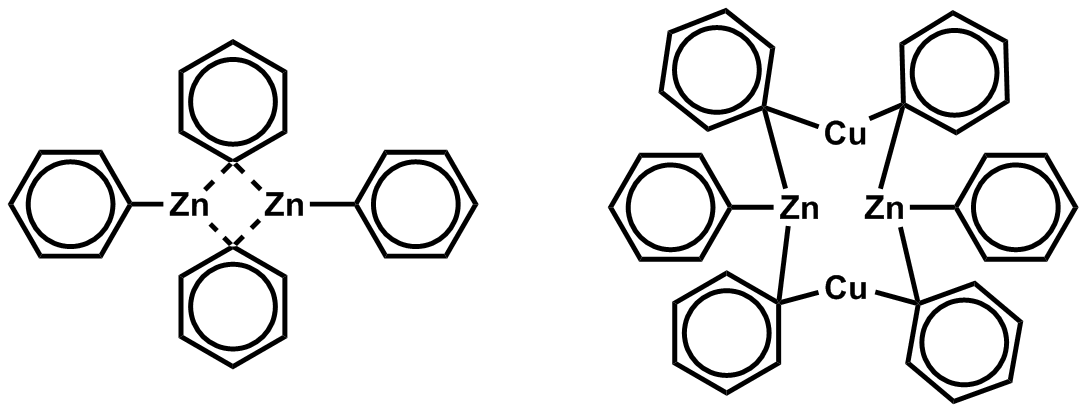|
Diisopropylzinc
Diisopropylzinc is an organozinc compound with the chemical formula ZnC6H14. It is the key reagent in the Soai reaction, which is both autocatalytic and enantiospecific. This chemical is pyrophoric A substance is pyrophoric (from grc-gre, πυροφόρος, , 'fire-bearing') if it ignites spontaneously in air at or below (for gases) or within 5 minutes after coming into contact with air (for liquids and solids). Examples are organolit ..., bursting into flame in air or in contact with water. It is generally packaged in toluene. References Organozinc compounds Isopropyl compounds {{Organic-compound-stub ... [...More Info...] [...Related Items...] OR: [Wikipedia] [Google] [Baidu] |
Organozinc Compound
Organozinc compounds in organic chemistry contain carbon (C) to zinc (Zn) chemical bonds. Organozinc chemistry is the science of organozinc compounds describing their physical properties, synthesis and reactions.The Chemistry of Organozinc Compounds' (Patai Series, (Eds. Z. Rappoport and I. Marek), John Wiley & Sons: Chichester, UK, 2006, .''Organozinc reagents – A Practical Approach'', (Eds. P. Knochel and P. Jones), Oxford Medical Publications, Oxford, 1999, . Organozinc compounds were among the first organometallic compounds made. They are less reactive than many other analogous organometallic reagents, such as Grignard and organolithium reagents. In 1848 Edward Frankland prepared the first organozinc compound, diethylzinc, by heating ethyl iodide in the presence of zinc metal.E. Frankland, Liebigs Ann. Chem.,1849, 71, 171 This reaction produced a volatile colorless liquid that spontaneous combusted upon contact with air. Due to their pyrophoric nature, organozinc compounds a ... [...More Info...] [...Related Items...] OR: [Wikipedia] [Google] [Baidu] |
Chemical Formula
In chemistry, a chemical formula is a way of presenting information about the chemical proportions of atoms that constitute a particular chemical compound or molecule, using chemical element symbols, numbers, and sometimes also other symbols, such as parentheses, dashes, brackets, commas and ''plus'' (+) and ''minus'' (−) signs. These are limited to a single typographic line of symbols, which may include Subscript and superscript, subscripts and superscripts. A chemical formula is not a chemical nomenclature, chemical name, and it contains no words. Although a chemical formula may imply certain simple chemical structures, it is not the same as a full chemical structural formula. Chemical formulae can fully specify the structure of only the simplest of molecules and chemical substances, and are generally more limited in power than chemical names and structural formulae. The simplest types of chemical formulae are called ''empirical formulae'', which use letters and numbers ind ... [...More Info...] [...Related Items...] OR: [Wikipedia] [Google] [Baidu] |
Soai Reaction
In organic chemistry, the Soai reaction is the alkylation of pyrimidine-5-carbaldehyde with diisopropylzinc. The reaction is autocatalytic and leads to rapidly increasing amounts of the same enantiomer of the product. The product pyrimidyl alcohol is chiral and induces that same chirality in further catalytic cycles. Starting with a low enantiomeric excess produces a product with very high enantiomeric excess. The reaction has been studied for clues about the origin of homochirality among certain classes of biomolecules. : The Japanese chemist Kensō Soai (1950–) discovered the reaction in 1995. For his work in "elucidating the origins of chirality and homochirality", Soai received the Chemical Society of Japan award in 2010. Other chiral additives can be used as the initial source of asymmetric induction, with the major product of that first reaction being rapidly amplified. For example, Soai's group has demonstrated that even chiral quaternary hydrocarbons, which have no clear ... [...More Info...] [...Related Items...] OR: [Wikipedia] [Google] [Baidu] |
Pyrophoricity
A substance is pyrophoric (from grc-gre, πυροφόρος, , 'fire-bearing') if it ignites spontaneously in air at or below (for gases) or within 5 minutes after coming into contact with air (for liquids and solids). Examples are organolithium compounds and triethylborane. Pyrophoric materials are often water-reactive as well and will ignite when they contact water or humid air. They can be handled safely in atmospheres of argon or (with a few exceptions) nitrogen. Class D fire extinguishers are designated for use in fires involving pyrophoric materials. A related concept is hypergolicity, in which two compounds spontaneously ignite when mixed. Uses The creation of sparks from metals is based on the pyrophoricity of small metal particles, and pyrophoric alloys are made for this purpose. The sparking mechanisms in lighters and various toys, using ferrocerium; starting fires without matches, using a firesteel; the flintlock mechanism in firearms; and spark testing ferrou ... [...More Info...] [...Related Items...] OR: [Wikipedia] [Google] [Baidu] |
Organozinc Compounds
Organozinc compounds in organic chemistry contain carbon (C) to zinc (Zn) chemical bonds. Organozinc chemistry is the science of organozinc compounds describing their physical properties, synthesis and reactions.The Chemistry of Organozinc Compounds' (Patai Series, (Eds. Z. Rappoport and I. Marek), John Wiley & Sons: Chichester, UK, 2006, .''Organozinc reagents – A Practical Approach'', (Eds. P. Knochel and P. Jones), Oxford Medical Publications, Oxford, 1999, . Organozinc compounds were among the first organometallic compounds made. They are less reactive than many other analogous organometallic reagents, such as Grignard and organolithium reagents. In 1848 Edward Frankland prepared the first organozinc compound, diethylzinc, by heating ethyl iodide in the presence of zinc metal.E. Frankland, Liebigs Ann. Chem.,1849, 71, 171 This reaction produced a volatile colorless liquid that spontaneous combusted upon contact with air. Due to their pyrophoric nature, organozinc compounds a ... [...More Info...] [...Related Items...] OR: [Wikipedia] [Google] [Baidu] |


